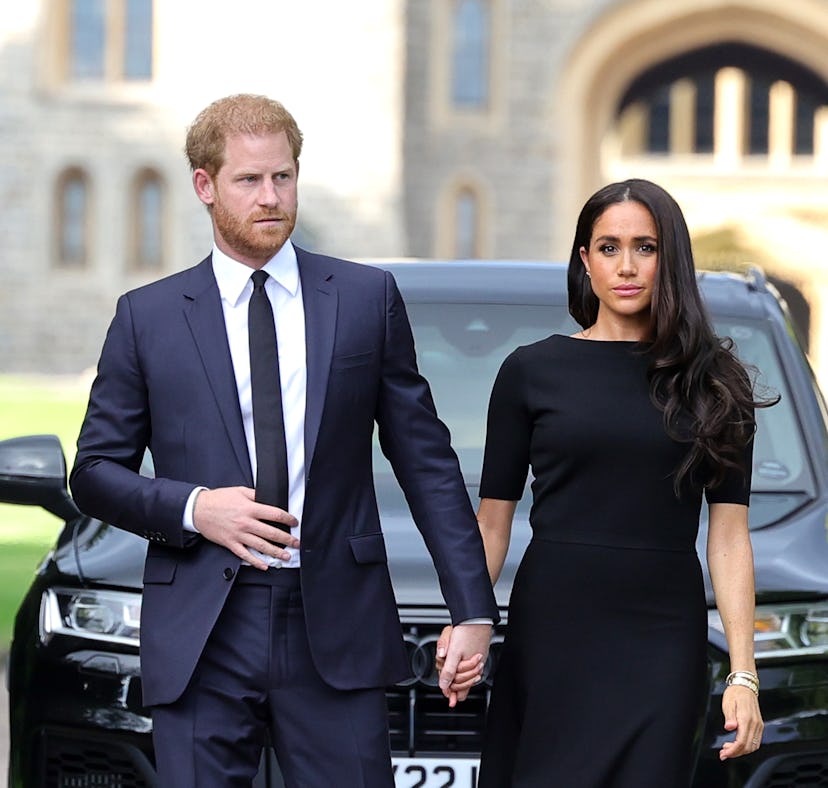
Harry And Meghan Were Reportedly "In Sync" At The Queen's Coffin Procession
A body language expert breaks down their "somber" expressions and "intimate" gestures.
It’s a sad day in the United Kingdom. On Sept. 14, the royal family marched alongside the late Queen Elizabeth II’s coffin in a procession from Buckingham Palace to Westminster Hall. King Charles III, Prince Harry, Prince William, and Kate Middleton were all there to mourn the queen, who “died peacefully” on Sept. 8 at 96 years old, per a statement from the palace. The procession included Prince Harry and Meghan Markle, who left Westminster Hall hand-in-hand. According to a body language expert, Harry and Meghan’s body language during the procession was “in sync,” speaking to their strength as a couple.
Harry and Meghan have a notoriously complicated relationship with the royal family. In March 2020, the Duke and Duchess of Sussex infamously left their royal duties behind, a move that made them the subject of plenty of criticism. In 2021, she alleged the “most senior people” who work with the royal family refused to get her help when she was experiencing suicidal ideation. It’s no wonder, then, that the couple leaned on each other during their trip back to London to honor Queen Elizabeth’s life — and their body language seems like proof they found solace in one another.
Their body language at the procession was interesting — they held hands, while the Duke and Duchess of Wales (those are some of Will and Kate’s new titles, FYI) did not. So, what does it all mean? Patti Wood, body language expert and author of SNAP: Making the Most of First Impressions, Body Language, and Charisma, breaks it all down.
Even though the royal family is known for rarely showing PDA, Harry and Meghan’s hand-hold was pretty typical of them. Wood says they’re “almost always” together like that at public events, “typically within an intimate zone of space, within zero to 14 inches from each other.”
It’s one thing to hold hands while posing for a photo. But according to Wood, the gesture is even more meaningful when a couple is in motion. “They’re close [and] in sync with each other,” she observes. It’s a sign that they’re likely very in tune with each other’s feelings.
Another common Sussex trait was on display: matching facial expressions. They often mirror each other in this way. According to Wood, their similar “somber, but not over the top” looks can indicate they’re “helping each other’s emotional equilibrium” — aka being each other’s rock.
While that might not sound like such a big deal, Wood says that couples wearing matching expressions is actually less common than you might think. It “typically signals that it’s a happy and healthy couple,” which again, bodes well for the Archewell founders.
Wood says Meghan appeared more “demure” here than she usually does. That makes sense — she was reportedly “not warmly welcomed” by the royal family in the hours and days following the queen’s death. While Harry traveled to Balmoral, where the queen died, Meghan was reportedly not invited. (Kate didn’t travel to the Scottish castle, either; it was Prince George, Princess Charlotte, and Prince Louis’ first day of school.)
Meanwhile, Will and Kate demonstrated the same formal, traditional body language that royals have used for generations. “There are things that they are taught... and they follow those rules,” Wood says. In other words, don’t expect any hand-holding from them any time soon.
The monarch’s coffin will remain at Westminster Hall for four days so visitors from around the world can pay their respects. After that, she will be laid to rest at Windsor Castle on Monday, Sept. 19. As Harry and Meghan mourn the loss of his beloved grandmother over the next few days and beyond, at least they can lean on each other. They’ve already proven it.